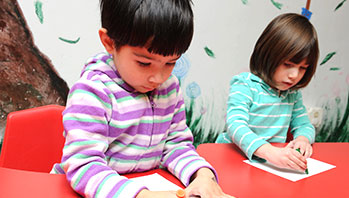- construction paper (for book cover)
- crayons and markers
- drawing paper
- stapler
- angry
- feel
- friend
- happy
- silly
- worried
MA Standards:
Speaking and Listening/SL.PK.MA.4: Describe personal experiences; tell real or imagined stories.
Speaking and Listening/SL.PK.MA.5: Create representations of experiences or stories (e.g., drawings, constructions with blocks or other materials, clay models) and explain them to
others.
Writing/W.PK.MA.3: Use a combination of dictating and drawing to tell a real or imagined story.
Head Start Outcomes:
Social Emotional Development/
Social Relationships: Recognizes and labels others’ emotions.
Logic & Reasoning/Symbolic Representation: Represents people, places, or things through drawings, movement, and three-dimensional objects.
Literacy Knowledge/Early Writing: Uses scribbles, shapes, pictures, and letters to represent
objects, stories, experiences, or ideas.
PreK Learning Guidelines:
English Language Arts 2: Participate actively in discussions, listen to the ideas of others, and ask and answer relevant questions.
English Language Arts 3: Communicate personal experiences or interests.
English Language Arts 5: Listen to and use formal and informal language.
English Language Arts 16: Use their own words or illustrations to describe their experiences, tell imaginative stories, or communicate information about a topic of interest.
English Language Arts 18: Use emergent writing skills to make letters in many settings and for many purposes.
Health Education 16: Recognize and describe or represent emotions such as happiness, surprise, anger, fear, sadness.
Draw and Write Together: Friends and Feelings

© Commonwealth of Massachusetts, Department of Early Education and Care (Jennifer Waddell photographer). All rights reserved.
Talk about the various feelings Trixie and Sonja had throughout Knuffle Bunny Too.
Discuss how friends can feel lots of different feelings when they are together. Say, Who can tell me about a time when they felt happy (angry, happy, silly, worried) with a friend?
Play a game of charades with feelings. Model different facial expressions and have children name and repeat the expression.
Invite children to tell you about a time they were with a friend and had a <happy, sad, scared, etc.> feeling. Then have them draw a picture of their facial expression and their friend’s expression at that time. Encourage children to dictate or write at the bottom of the drawing how they are feeling in the picture.
Assemble the pictures in a “Me and My Friend” book for children to read in the Library Center.
Educator Tip: Some children may not have the right words to accurately describe how they are feeling. Be cautious of answering for children and labeling their emotions too soon. Teach a variety of emotion words so children can describe when they are frustrated, anxious, or embarrassed.
